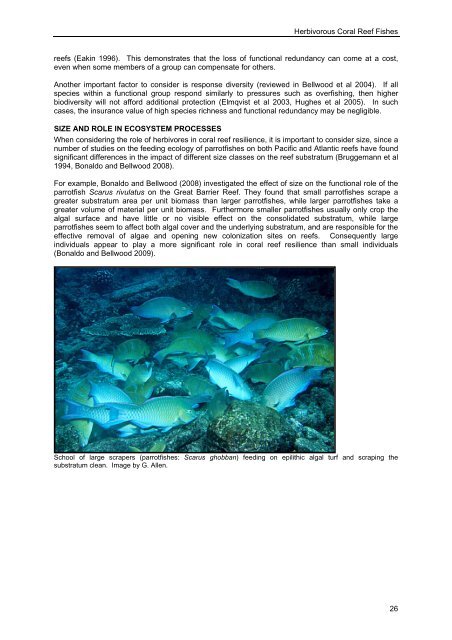Green2009-herbivore monitoring
Green2009-herbivore monitoring.pdf
Green2009-herbivore monitoring.pdf
Create successful ePaper yourself
Turn your PDF publications into a flip-book with our unique Google optimized e-Paper software.
Herbivorous Coral Reef Fishes<br />
reefs (Eakin 1996). This demonstrates that the loss of functional redundancy can come at a cost,<br />
even when some members of a group can compensate for others.<br />
Another important factor to consider is response diversity (reviewed in Bellwood et al 2004). If all<br />
species within a functional group respond similarly to pressures such as overfishing, then higher<br />
biodiversity will not afford additional protection (Elmqvist et al 2003, Hughes et al 2005). In such<br />
cases, the insurance value of high species richness and functional redundancy may be negligible.<br />
SIZE AND ROLE IN ECOSYSTEM PROCESSES<br />
When considering the role of <strong>herbivore</strong>s in coral reef resilience, it is important to consider size, since a<br />
number of studies on the feeding ecology of parrotfishes on both Pacific and Atlantic reefs have found<br />
significant differences in the impact of different size classes on the reef substratum (Bruggemann et al<br />
1994, Bonaldo and Bellwood 2008).<br />
For example, Bonaldo and Bellwood (2008) investigated the effect of size on the functional role of the<br />
parrotfish Scarus rivulatus on the Great Barrier Reef. They found that small parrotfishes scrape a<br />
greater substratum area per unit biomass than larger parrotfishes, while larger parrotfishes take a<br />
greater volume of material per unit biomass. Furthermore smaller parrotfishes usually only crop the<br />
algal surface and have little or no visible effect on the consolidated substratum, while large<br />
parrotfishes seem to affect both algal cover and the underlying substratum, and are responsible for the<br />
effective removal of algae and opening new colonization sites on reefs. Consequently large<br />
individuals appear to play a more significant role in coral reef resilience than small individuals<br />
(Bonaldo and Bellwood 2009).<br />
School of large scrapers (parrotfishes: Scarus ghobban) feeding on epilithic algal turf and scraping the<br />
substratum clean. Image by G. Allen.<br />
26


















